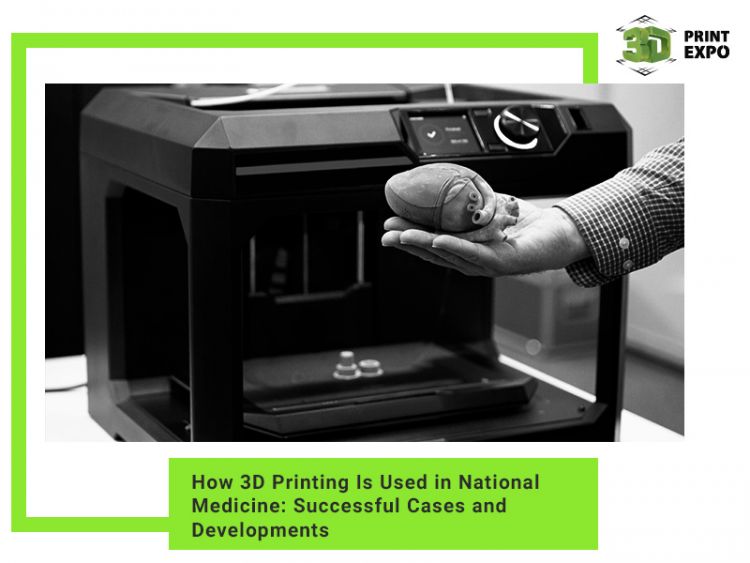How 3D Printing Is Used in National Medicine: Successful Cases and Developments

How do additive technologies help physicians and hospitals? In what fields do 3D printing technologies find use in our country? Let us review successful case uses in Russian medicine.
Use of 3D printing in the world practice
Additive technologies were first officially used in medicine in 1999 when members of the Wake Forest Institute for Regenerative Medicine made an implantation surgery using computer tomography and a 3D printer.
Currently, 3D printing represents a rather wide range of directions and capabilities in medicine. Some of them are:
- creation of implants;
- printing of bones;
- modeling of internal organs;
- development of medical tools for physicians.
3D printing in medicine allows modeling and creating high-precision dental implants, prostheses, organ prototypes. Besides, 3D printing helps specialists and physicians to study more efficiently and improve qualification, practice, and draft precise surgery plans.
With the arrival of new advanced printing machines and the increasing number of materials, additive technologies are rapidly developing in medicine. 3D printing is most actively used in the USA.
For example, a patient from Florida was first implanted a 3D printed finger bone in 2019. Associate professor of radiology and cardiology at the University of Kentucky Michael Winkler developed a 3D printed heart model to help physicians work. Such prototypes of organs help surgeons to plan surgeries more precisely and increase chances for quick recovery of patients.

How do medical 3D technologies develop in Russia?
There is a number of successful companies in Russia that produce 3D printing machines and materials, develop additive technologies in different fields (including PICASO 3D, Imprinta, Anisoprint, Cvetnoy Mir, and many others). National medicine has also achieved some success using 3D technologies.
For example, specialists of Federal State Budgetary Educational Institution of Higher Education “Privolzhsky Research Medical University” of the Ministry of Health of the Russian Federation, Nizhny Novgorod, performed two successful surgeries back in 2016 – implanted 3D printed hip prostheses.
Since 2015, the Hospital of Saint Petersburg State Pediatric Medical University has been performing heart surgeries that are planned using 3D printed organ prototypes. An important characteristic of such prototypes is that they are modelled taking into account all anatomic features of the person and help surgeons to perform all necessary procedures faster and more accurately. In the process of treating cardiac failures, this reduces surgery time and risks of complications.
You can learn more about the use of additive technologies in modern Russian medicine from the report of the Head of Additive Technologies Laboratory at Privolzhsky Research Medical University Roman Gorbatov that will speak at the seventh 3D Print Expo on October 4.
Russian “bone cement” to treat fractures
Scientists of different countries of the world work on the invention of the optimal material for 3D printing of bones. For example, researchers of the US Northwestern University invented elastic and at the same time strong material in 2016. Russian specialists developed a tissue that can become an alternative to titanium implants.
Specialists of the National Research Nuclear University have developed a biocompatible with human body material intended to print bones. It is based on a composition made of animal bones and is not rejected upon implantation for this reason. This material is rather flexible but quickly hardens and then gradually dissolves: the organism manages to joint fractions quickly and without side inflammatory processes.

This significantly speeds up treatment, reduces risks of complications, and eliminates the necessity to perform a redo surgery unlike the situation when you implant titanium implants that have to be removed in some time.
This technology is realized in the following way: bio-cement is uploaded in a 3D printer and the broken bone is scanned. Basing on the obtained data, specialists design a 3D model of the fragment that has to be printed. An implant is produced according to the accurate model from the bone cement uploaded in the printer, and the material hardens in the process of production, becoming solid and firm.
Prospects of 3D printing technologies in Russian medicine
In Russia, Rusatom – Additive Technologies specializes in the development of the additive technology field. This company is the main industry integrator that unites several enterprises. In 2020, Rusatom plans to start the release of 3D printed medical implants. The company’s CEO Alexey Dub also shares plans to develop relevant software.
The project is currently developed at RF State Research Center JSC “RPA “CNIITMASH”, which is one of Rusatom’s institutions. The end product is an SLM printer with a triaxial lens system that will print items using metal powder bed fusion technology. According to representatives of Rusatom, printed items will be anatomically precise and ready-to-use. It is important that facilities undergo trials in corresponding agencies and are officially fit for use.
Using such an SLM printer, medical workers will have a possibility to create individual implants for any person quickly (basing on tomography data and other research). The Russian printer will cost less than foreign analogues.
The production speed of the machine by Rusatom – Additive Technologies is 5-50 cubic centimeters per hour. Such speed will help to provide patients will all necessary implants in the shortest time possible, speeding up treatment and helping to service more people in a certain period of time.
CEO of Rusatom Alexey Dub will open the lectures session of 3D Print Expo 2019 with the welcome speech and will participate in the roundtable “CAE in additive technologies – the market of solutions for future”.







